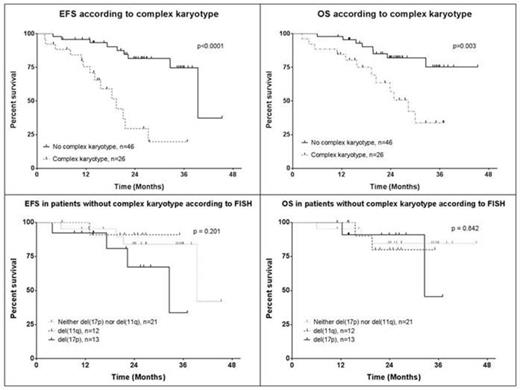Abstract

Background.
Ibrutinib is active in relapsed/refractory (R/R) CLL, including patients (pts) with del(17p); pts with del(17p) have similar response rate to pts without, but have shorter progression-free survival and a pattern of continuous relapses. (Byrd NEJM 2013). It is unknown whether subpopulations of pts with del(17p) with distinct clinical courses can be identified. Del(17p) is frequently associated with a complex metaphase karyotype (CKT), defined as ≥3 distinct chromosomal abnormalities. CKT has been associated with inferior outcomes in treatment-naïve and R/R CLL, but its prognostic significance in ibrutinib-treated pts is unknown.
Methods.
We reviewed 100 pts treated for R/R CLL at MD Anderson Cancer Center with investigational ibrutinib-based regimens from 2010-2013. 50 pts received ibrutinib (Ib) monotherapy, 36 Ib plus rituximab and 14 Ib + bendamustine and rituximab (BR). All pts provided informed consent and studies were conducted according to the declaration of Helsinki. Pre-treatment FISH and CpG-stimulated metaphase cytogenetic analysis was performed on bone marrow.
Results.
Pt characteristics are shown below:
| Characteristic . | . |
|---|---|
| Age, median (range) | 65 (35-83) |
| # prior therapies, median (range) | 2 (1-12) |
| FISH hierarchy, n (%) (n=95) | |
| del(11q) | 26 (28) |
| del(17p) | 46 (49) |
| Complex karyotype, n (%) (n=72) | 26 (36) |
| Unmutated IGHV gene, n (%) (n=98) | 80 (81) |
| Fludarabine-refractory, n | 19 |
| β2-microglobulin ≥4.0, n (%) | 48 (56) |
| Characteristic . | . |
|---|---|
| Age, median (range) | 65 (35-83) |
| # prior therapies, median (range) | 2 (1-12) |
| FISH hierarchy, n (%) (n=95) | |
| del(11q) | 26 (28) |
| del(17p) | 46 (49) |
| Complex karyotype, n (%) (n=72) | 26 (36) |
| Unmutated IGHV gene, n (%) (n=98) | 80 (81) |
| Fludarabine-refractory, n | 19 |
| β2-microglobulin ≥4.0, n (%) | 48 (56) |
22/26 pts with CKT had del(17p), [OR 19.2 (4.9-76.4) compared to non-del(17p) pts, p<0.001]; 3 had del(11q). 1 did not have FISH results available. There was no association between CKT and other baseline characteristics. 35/46 pts with del(17p) had metaphase cytogenetics performed. Karyotype was abnormal in 33/35. Mechanisms of TP53 loss were: unbalanced translocations, -17, del(17p) and i(17q) in association with CKT (n=22), del(17p) in the absence of CKT (n=3) and TP53 loss identified by FISH only (n=10).
The overall response rate (ORR) for the entire population was 95%, with 16% complete remission (CR). ORR was not different according to baseline characteristics. CR rate was 50% among pts who received Ib + BR versus 10.7% in those combined who received Ib or Ib + rituximab [OR 40.1 (3.0-538.5), p=0.005]. There was a trend toward lower CR rate on multivariable analysis (MVA) for pts with B2M ≥4.0 (p=0.055).
Median follow-up in surviving pts was 27mo. On univariable analyses (UVA), the following were significantly associated with event-free survival (EFS): fludarabine-refractory CLL [median EFS 27mo vs. not reached (NR), p=0.025], del(17p) (27mo vs. NR, p=0.008) and CKT (16 vs. 39mo, p<0.0001). There was no association between del(17p) and EFS when pts with CKT were excluded. On MVA, only CKT was significantly associated with EFS [HR 4.1 (1.3-13.4), p=0.018]. On UVA, the following were significantly associated with survival (OS): fludarabine-refractory CLL (28mo vs. NR, p=0.009), del(17p) (33mo vs. NR, p=0.024) and CKT (24mo vs. NR, p=0.003), with no association between del(17p) and OS when pts with CKT were excluded (Figure). There was a trend toward inferior OS in pts with baseline B2M ≥4.0 (42mo vs. NR, p=0.07). On MVA, fludarabine-refractory CLL [HR 5.6 (1.7-17.9), p=0.004], CKT [HR 5.1(1.5-17.5), p=0.009] and B2M ≥4.0 [HR 3.3 (1.0-10.4), p=0.044] were all significantly associated with inferior OS. There was no association between del(17p) and OS.
EFS and OS were significantly longer in pts who achieved CR compared with PR (p<0.001). Pts with primary refractory disease had poor outcomes. 5 pts developed Richter Syndrome, of whom 4 had CKT.
Discussion.
The presence of CKT is independently associated with inferior EFS and OS in pts with relapsed/refractory CLL treated with Ib, while del(17p) is not. CKT is strongly associated with del(17p) and may be a key determinant of biological behavior in del(17p) CLL. This has important implications for treatment of pts with del(17p); those without CKT appear to have equivalent outcomes with Ib compared to pts without del(17p) and could potentially be managed with long-term Ib and close monitoring. In contrast, the inferior outcomes after initial response in pts with CKT make them ideal candidates for treatment-intensification strategies after initial Ib-based treatment, either with novel drug combinations or with allogeneic stem cell transplant, ideally in the context of well-designed clinical trials.
Wierda:Pharmacyclics: Consultancy. O'Brien:Pharmacyclics: Research Funding. Burger:Pharmacyclics: Research Funding.
Author notes
Asterisk with author names denotes non-ASH members.

This icon denotes a clinically relevant abstract


This feature is available to Subscribers Only
Sign In or Create an Account Close Modal